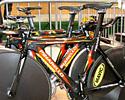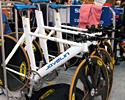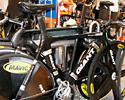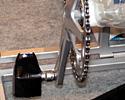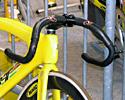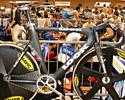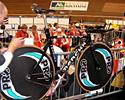
Recently on Cyclingnews.com |
Bikes of the 2006 world track championships, April 17, 2006The scales tip to carbonMal Sawford takes a stroll round the infield at the Track World Championships and finds lots of carbon fiber and a surprising range of bike weights. There's a certain purposeful purity about track bikes, but that doesn't stop teams and manufacturers from taking a stripped-down bike with no gears, brakes or freewheel and trying to tweak it so that every last Watt of rider power goes into forward motion. For the against-the-clock disciplines that means coming up with ever more streamlined machines, while carefully staying within the UCI's regulations for what constitutes a legal bike. Sprinters, on the other hand, are more interested in absolute stiffness and in staying firmly locked in the pedals as they crank out their 2100 Watt peaks in the final dash to the line. Some of the major brands present included Look (the KG 496), Pinarello (with its 'Montello Pista') and of course, BT (Bike Technologies), among other brands - large and small - and one-off sponsorship deals with athletes. Where track bikes were once almost exclusively all-steel – even the handlebars – carbon fiber has taken over as both a frame material and for components such as seatposts, bars and wheels. It's not the low weight possible with carbon that track riders are after, though. We got chatting to the UCI technical scrutineers in Bordeaux and found out that none of the bikes they'd weighed came even close to the UCI's minimum weight of 6.8kg, despite the missing components compared to a road bike. The carbon takeover comes down to aerodynamics and stiffness. A carbon structure can be made any shape you like, which means a design that cuts the air efficiently is easier to achieve, and adding extra material to stiffen crucial areas such as the bottom bracket is straightforward, if labour-intensive. The weight range of the beikes at Bordeaux is quite surprising, nevertheless. At a shade under 7kg, Pendleton's was the lightest of the ones for which we have numbers; the heaviest was one of the Koga-badged BTs used by a member of the Dutch team pursuit squad. Bike weights at the 2006 world track championshipsVictoria Pendleton's Merton 6.99 Natallia Tsylinskaya's Look 7.26 Damian Zielinski's Isaac 7.42 Clara Sanchez' Look 7.70 Roberto Chiappa's Pinarello 7.81 Maximilian Levy's FES 7.90 Theo Bos' Koga/BT 7.96 Dutch team pursuit Koga/BT 8.10 Stefan Nimke's FES 8.11 Tuen Mulder's Koga/BT 8.38 Dutch team pursuit Koga/BT 8.70 Dutch team pursuit Koga/BT 8.80 Dutch team pursuit Koga/BT 9.40 PhotographyFor a thumbnail gallery of these images, click here Images by Mal Sawford/Cyclingnews
|

